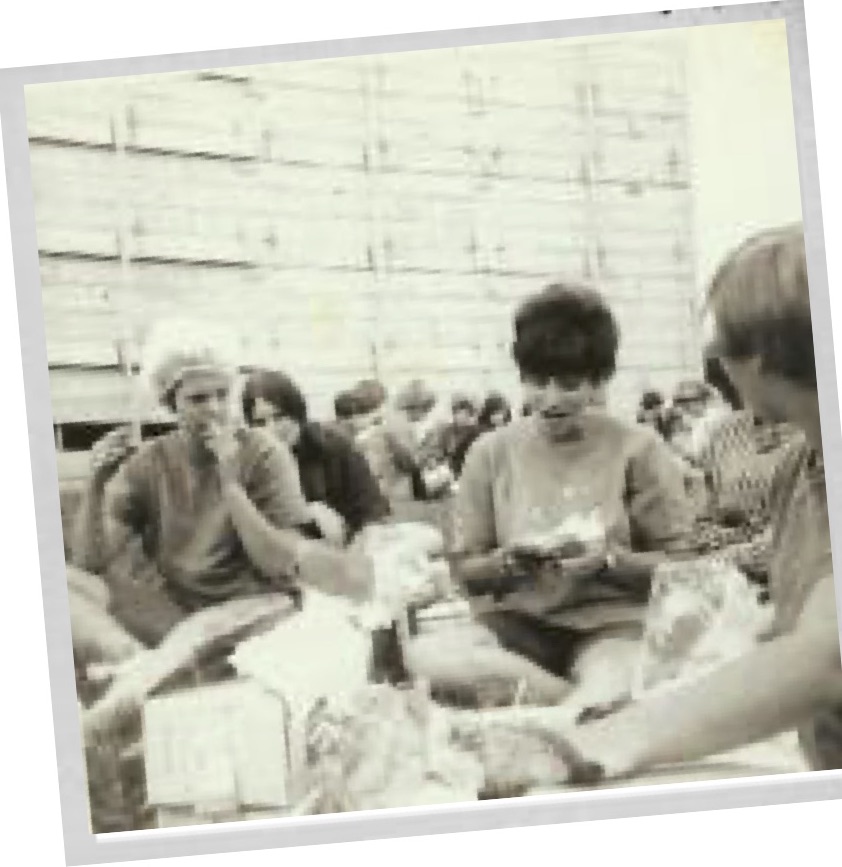
Lunch was two sandwiches, a fruit, and a drink consumed while sitting on the ground outside a tobacco shed, Hatheway-Steane Corporation, 1967. Courtesy of Connie Robinson
By Connie Robinson
(c) Connecticut Explored Inc. Summer 2011
Subscribe/Buy the Issue!
Tobacco farming was once a flourishing enterprise in the Suffield Valley. As early as 1905 there were 15 large tobacco houses in Suffield with payrolls that had a strong influence on the local economy. The first commercial air-conditioning to wash and filter air was installed by Carrier and in the tobacco warehouse of William S. Pinney.
In the 1960s, when I became personally acquainted with the industry, shade tobacco fields were like a patchwork quilt spreading over hundreds of acres in Suffield. Finding reliable field and shed help locally was still problematic, as it had been for 40 years. One source of labor was 500 miles away, in western Pennsylvania, where the steel mills were closing and the economy was suffering. Recruiters from Connecticut visited the area to offer young women like me a chance at a summer job. The offer included room, board, a weekly salary, and bus transportation from Pennsylvania to Connecticut and back home and to work every day. We were all white girls, mostly from working, blue-collar families. My father owned the Majestic Theater in my hometown of Ellwood City. Other girls came from Beaver Falls, Ambridge, New Castle, and other surrounding steel mill towns. For many of us, this was how we earned money for college.
At 17 years old, and as a graduating senior in high school, this seemed a promising opportunity. My 19-year-old sister and I boarded the bus in early summer 1967 to go to a part of the country where neither of us had ever been. We had no idea what awaited us. Arriving in Connecticut tired, we were ushered into cabins. Our cabin had seven bunk beds for 14 girls and one shower. But we were treated well by our employers, the Hatheway-Steane Corporation. They delivered on their promises. We were given three good meals a day, and our accommodations were more than adequate. Our cabin had a screened-in porch with a rocker, and Lake Congamond was just over the hill.
My job was in the shed. The tobacco leaves were brought to us from the field in canvas holders. We picked up the leaves and placed them stem to stem on a large work table. Two girls stood facing each other. As the lath, a thin narrow strip of wood, came across on a conveyor belt, we had to quickly alternate the leaf stems on the lath. This was called “sewing.” From there, male workers from Puerto Rico picked up the laths and hiked up into the rafters for the leaves to dry.
My partner was not my sister but an acquaintance from home. She and I would talk, sing, and laugh to pass the time and offset the tedium of the work. We would lean into the table to sew and reach the lath, and the juices from the tobacco would get on our jeans. We had two exclusive pairs of jeans for this work, which I am certain we never wore again. Still, my clearest memory was riding the bus one morning thinking, “This is the most beautiful country. I hope that I can return to it some day.” My sister told me recently that she also had that same exact thought.
We had a lunch break of two sandwiches, fruit, and a drink. At 4:30, it was back on to the buses to the cabins. Once off the bus, we would call dibs for first in the shower, just to feel clean and cool. I recall vividly calling out “first in the shower!” and jumping off the bus. Some would walk over the hill to the lake and go for a swim. In the evening, as there was no television, we would read, write letters home, listen to the radio, or play cards. That was the summer that I read Margaret Mitchell’s Gone With the Wind. On Friday evenings we were taken to a local town, where we would go to Friendly’s. We didn’t have Friendly’s in western Pennsylvania, so this was a treat. At the end of the season, Hatheway-Steane took us to Ocean Beach Park in New London. For the majority of us, it was our first time on a beach and our first glimpse of the ocean.
With the help of Lester Smith, Suffield historian and King House museum curator, I was able to locate the Hatheway-Steane headquarters on Warnertown Road. It is now the Tuckahoe Turf Farm. The cabins do not exist any more.
I never returned to work another summer in the tobacco sheds, but that summer provided memories for a lifetime. But I did return to “the most beautiful country” I discovered that summer I worked tobacco.
Connie B. Robinson of West Hartford is the immediate past chair of the Noah Webster House & West Hartford Historical Society.
Connie thanks Rich Malley, Connecticut Historical Society, and Lester Smith, Suffield Historical Society, for assistance with this story.
Explore!
“Laboring in the Shade,” Summer 2011
“Tobacco Valley: Puerto Rican Farm Workers in Connecticut,” Fall 2002
“The Luddy-Taylor Tobacco Museum,”
